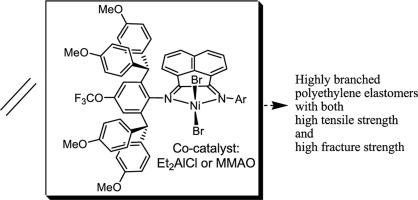European Polymer Journal ( IF 5.8 ) Pub Date : 2023-12-01 , DOI: 10.1016/j.eurpolymj.2023.112649 Yuting Zheng , Quanchao Wang , Yiping Che , Shu Jiang , Zhixin Yu , Yizhou Wang , Yanping Ma , Gregory A. Solan , Tongling Liang , Wen-Hua Sun

|
Polyolefinic materials displaying bimodal molecular weight distributions are of interest since they can potentially provide mechanical toughness from the high molecular weight component without losing processability on account of the low molecular weight component. With this in mind, a series of nickel(II) complexes, [1-[2,6-{(4-MeOC6H4)2CH}2–4-(F3CO)C6H2N]-2-(ArN)C2C10H6]NiBr2 (Ar = 2,4-Me2C6H3 Ni1, 2,6-Et2C6H3 Ni2, 2,6-iPr2C6H3 Ni3, 2,4,6-Me3C6H2, Ni4, 2,6-Et2-4-MeC6H2 Ni5, 2,6-Me2C6H3 Ni6) have been synthesized and have shown, following treatment with MMAO or Et2AlCl, excellent activity for the polymerization of ethylene (up to 19.87 × 106 g (PE) mol−1 for Ni4/Et2AlCl) generating high molecular weight branched polyethylene. More importantly, the elastomeric material produced using Et2AlCl as activator displays bimodal characteristics as well as low crystallinity and a medium to high branching density. By contrast, the material prepared using MMAO was more unimodal and showed higher crystallinity and lower branching density. Stress–strain and stress–strain recovery tests performed on the bimodal PE’s revealed a range of tensile properties with a sample prepared using Ni5/Et2AlCl combining both high tensile strength and high fracture strength (σ = 20.3 MPa, ε = 892.0 %). Conversely, a PE sample prepared using Ni4/Et2AlCl showed the highest elastic recovery with a stress relaxation (SR) value of 67.6 %. Besides branching analysis, molecular weight determinations and mechanical tests on the polymers, all nickel complexes and precursor 1,2-bis(arylimino)acenaphthenes, have been characterized by a combination of spectroscopic techniques, elemental analysis and in the cases of Ni1(OH2) and Ni4 by single crystal X-ray diffraction. A theory is also proposed to explain the observed bimodality.
中文翻译:

使用附加甲氧基和三氟甲氧基官能团的 N,N'-镍催化剂的高分子量双峰聚乙烯弹性体
显示出双峰分子量分布的聚烯烃材料是令人感兴趣的,因为它们可以潜在地提供来自高分子量组分的机械韧性,而不会由于低分子量组分而损失可加工性。考虑到这一点,一系列镍(II)络合物,[1-[2,6-{(4-MeOC 6 H 4 ) 2 CH} 2 –4-(F 3 CO)C 6 H 2 N]-2-(ArN)C 2 C 10 H 6 ]NiBr 2 (Ar = 2,4-Me 2 C 6 Ni1,2,6-Et 2 C 6 H 3 Ni2,2,6-iPr 2 C 6 H 3 Ni3, 2,4,6-Me 3 C 6 H 2 -4-MeC 6 H 2 Ni5, 2,6-Me 2 C 6 H 3 Ni6) 已被合成,并在用 MMAO 或 Et 2 AlCl 处理后显示出优异的乙烯聚合活性(高达到 19.87 × 10 6 g (PE) mol −1 (Ni4/Et 2 AlCl) 生成高分子量支化聚乙烯。更重要的是,使用Et 2 AlCl作为活化剂生产的弹性体材料表现出双峰特性以及低结晶度和中高支化密度。相比之下,使用 MMAO 制备的材料更加单峰,并表现出更高的结晶度和更低的支化密度。对双峰 PE 进行的应力-应变和应力-应变恢复测试揭示了使用 Ni5/Et 2 AlCl 制备的样品具有一系列拉伸性能,结合了高拉伸强度和高断裂强度 (σ = 20.3 MPa , ε = 892.0 %)。 相反,使用 Ni4/Et 2 AlCl 制备的 PE 样品显示出最高的弹性恢复,应力松弛 (SR) 值为 67.6%。除了聚合物的支化分析、分子量测定和机械测试之外,所有镍配合物和前体 1,2-双(芳基亚氨基)苊均通过光谱技术、元素分析以及 Ni1(OH < b36>)和Ni4的单晶X射线衍射。还提出了一种理论来解释观察到的双峰性。


















































 京公网安备 11010802027423号
京公网安备 11010802027423号